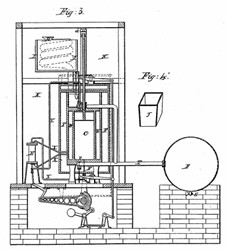The temperature in Hill City, KS topped out at 115 degrees on Wednesday, (8 degrees above its previous record for a June 27) making it the hottest spot in the country that day. Unfortunately, the Midwest town is located in the center of the most recent heat wave and has had the nation's highest temperatures for five days in a row.
Over 1,000 temperature records have been broken around the county this week, 251 on Tuesday alone. As I write this on Thursday, here is what the temperature map of the country looks like.

http://www.msnbc.msn.com/id/47991674/ns/weather/?ocid=ansmsnbc11#.T-ze9xee7PZ

Educated at the College of Physicians and Surgeons in Fairfield, New York. Gorrie would later move to Apalachicola, Florida, and become a resident physician at two local hospitals. He would also serve as Postmaster, President of the Bank of Pensacola's Apalachicola Branch, Secretary of the Masonic Lodge, and was one of the founding vestrymen of Trinity Episcopal Church.
Dr. Gorrie's main focus in Florida was medical research involved the study of tropical diseases such as yellow-fever and malaria. Gorrie hypothesized the cooling of sickrooms would aid in the recouperation of patients as well as control the spreading of the diseases. He noted that “Nature would terminate the fevers by changing the seasons” so he cooled the hospital sick rooms with ice in a basin suspended from the ceiling. Cool air, being heavier, flowed down across the patient and through an opening near the floor.
In 1844, Gorrie would begin experiments on making artificial ice and in 1845, he left his medical practice to pursue refrigeration projects full time. On May 6, 1851, Gorrie was granted Patent No.8080 for a machine that would artificially produce ice and obtained a partner to manufacture the machine.
Unfortunately, this was the height of the ice trading business. Traders such as the "Ice King", Frederic Tudor were aware of Gorrie's machine and hopes of getting financing to mass produce it. The story goes that Tudor launched a smear campaign against the new machine that could possibly put him and the many other traders out of business.
Gorrie's partner passed away suddenly and he was never able to raise enough money to bring his invention to market. Gorrie died in seclusion and poverty on June 29, 1855, but his technology lives on.

The Historical Inebriant: The Heat Wave
Ingredients:
1 oz. Coconut Rum
1 oz. Peach Schnapps
Pineapple Juice
Splash of Grenadine
Pour the coconut rum and peach schnapps into a glass with ice. Fill it with pineapple and add the splash of grenadine.



